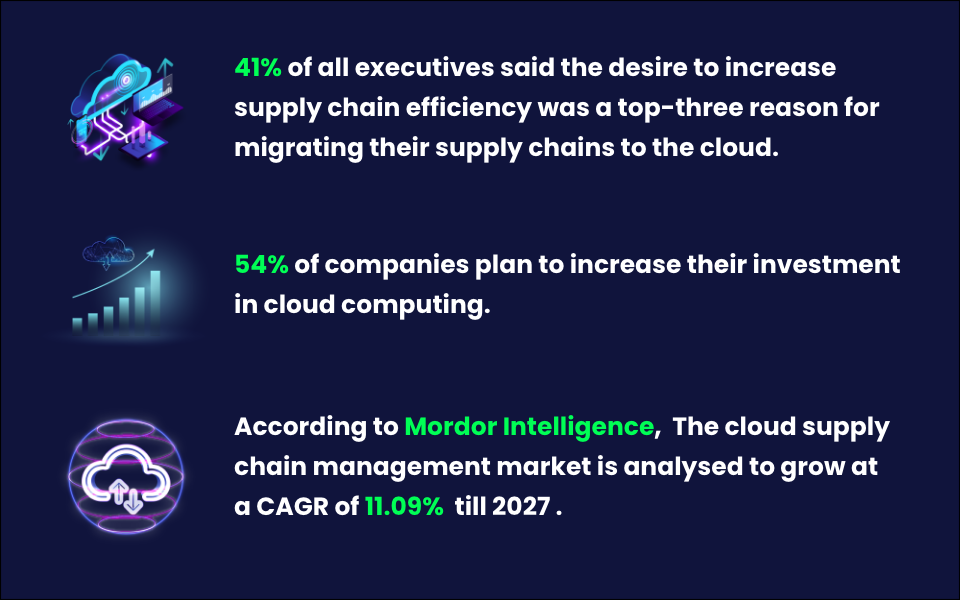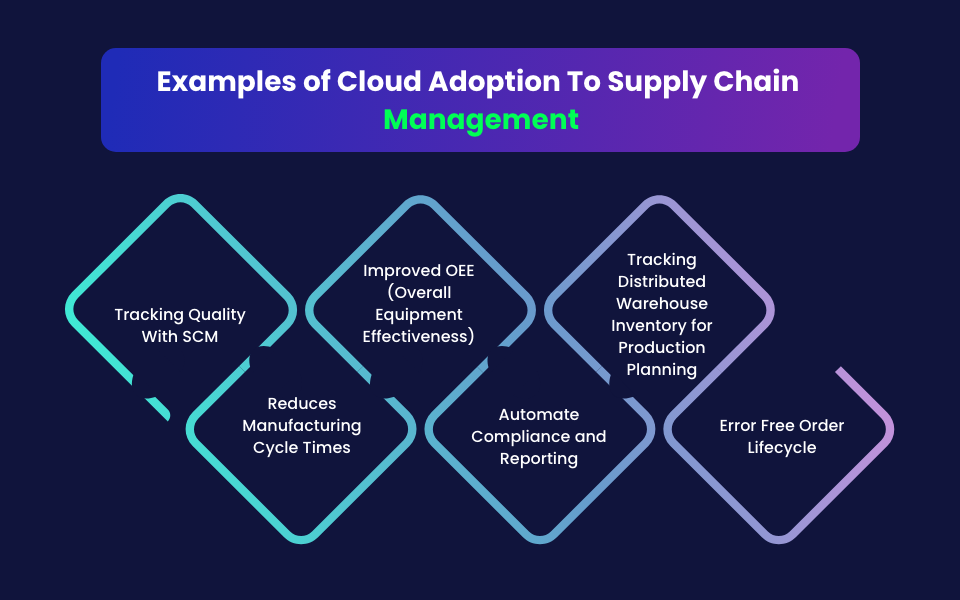There is a rush in digital transformation across every industry and supply chain management can’t afford to be the outlier. Post-pandemic industries have learned new lessons on how to run a business and most of them are embracing cloud computing to adapt to the changing dynamics of the market.
Today every business involving supply chain is thinking of adopting some kind of cloud solution in their digital transformation strategy. Here are some stats to show why?
Figures Indicating Cloud Adoption To Supply Chain Management

The study on cloud integration for supply chain management throws up some interesting facts.
- Accenture conducted a study on cloud computing adoption in the supply chain industry and some interesting facts they came up with are:
- supply chain executives reported a 16% decrease in operating costs across their supply chain after switching to cloud computing.
- 21% of supply chain executives have deployed cloud-enabled capabilities across their entire supply chain. 97% of these “cloud leaders” have at least 3/4 of their supply chains running in the cloud.
- 41% of all executives said the desire to increase supply chain efficiency was a top-three reason for migrating their supply chains to the cloud.
- Executives on average attributed their cloud use to a 26% increase in demand forecast accuracy, a 16% reduction in supply chain operating costs, and a 5% increase in revenue growth and profitability.
- About half of the executives surveyed said the cloud has helped them successfully increase resiliency (52%) and sustainability (48%).
- P&S Research estimates that cloud-based supply chain management solutions will exceed $11 billion by 2023.
- According to Mordor Intelligence, The cloud supply chain management market is analyzed to grow at a CAGR of 11.09% till 2027
- 54% of companies plan to increase their investment in cloud computing
Examples of Cloud Adoption To Supply Chain Management

Tracking Quality With SCM
SCM(Supply Chain Management) software is used in tracking and reporting quality levels in products. Quality is crucial to customer satisfaction and it helps to track it continuously from the start till the end. Tracking quality in real-time and uninterruptedly can avoid missing out on goof-ups.
Cloud-based SCM software aggregates various departments at the production center, product, and customer levels to have a synchronized watch over quality. It is also very easy to integrate various stakeholders in the supply chain on an ad-hoc basis for quality watching.
It is used for monitoring and tracing any assembly, component, or subassembly throughout the supply chain and gives real-time updates on shipment inspection schedules and quality level reports.
Reduces Manufacturing Cycle Times
Manufacturing Cycle Time or the time of a product’s journey from the origination of order to its storage in inventory is an important metric of efficient supply chain management. Cloud-based SCM can quickly gather information from across the globe on any deadlock.
Members of the supply chain can easily communicate across the cloud to sort out the problem. Managers can guide and share valuable insights on pinpointing the causes of delay and come up with uniform processes to optimize the manufacturing cycle time.
Improved OEE (Overall Equipment Effectiveness)
OEE is a crucial metric to a production equipment’s health. Good OEE ensures streamlined production and indicates optimized and coordinated performance from the production team. Traditional methods of OEE calculation takes into account a lot of factors such as machine’s health, maintenance schedule, and tool performance. Gathering so much data across the supply chain manually is itself a slow process.
Cloud supply chain software easily collects data from various points in the supply chain. It is very easy to calculate OEE with the assistance of cloud SCM software across the globe.
Automate Compliance and Reporting
Government and industrial bodies’ compliances need to be mandatorily maintained for a product to be legally launched in the market. These often involve carefully cataloging and creating reports with data collected from various stages of the supply chain.
Engaging resources to fill up these forms cutting off production strength hinders reaching full optimization. Without a globally connected supply chain often this data collection process can turn out to be time taking and slow down production.
Cloud-based software can aggregate data from various zones on a real-time basis. They can also be programmed with analytics and standards to automatically generate reports and also remark where there is a lack of adherence from the early stage.
Tracking Distributed Warehouse Inventory for Production Planning
Eliminating the demand-supply gap builds excellent customer relationships and also helps to prevent wastage from overproduction. Being able to track the inventory level at warehouses spread across geographies helps to come up with a robust production and distribution plan.
Cloud-based WMS (Warehouse Management Systems), ERP, and analytics systems can optimize inventory tracking and optimize manufacturing schedules. WMS, ERPs and analytic engines can also show patterns indicating shifting demand. With cloud-based software, manufacturers can expect to see profit and revenue growth gains.
Error Free Order Lifecycle
Product quality problems begin when some incorrect or incomplete order gets created. These errors can arise from pricing, quoting, product configuration, and wrong delivery instructions to slow down delivery leading to customer dissatisfaction.
Cloud-based applications with complete control over the order creation to delivery workflow can increase accuracy and reduce delay in invoice clearance. Some of the significant changes that a cloud-based application brings to reduce DSO (Day Sales Outstanding) are automatic and dynamic pricing, organized inventory, and an easy checkout process.
Cloud base Supply Chain Management – The Need Of The Hour
The growth of remote working environments has increased the importance of cloud-based solutions. A dearth of adequately qualified workers is now one of the most important hurdles to organizations embracing cloud computing. In contrast to in-house personnels lacking the most recent credentials and experience, cloud vendors can help with this difficulty by developing and safeguarding competitive cloud systems.
The cloud computing market is expected to grow by 20% over the next six years, therefore there has never been a better time for your company to invest in cloud computing.
